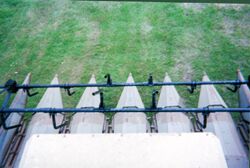
When Larry Smith went out to look at his corn crop after a storm blew through last year, he says "It looked like a culti-packer ran over it."
The Walnut Hill, Florida farmer adds, "After the wind blew it down, we had rain on it for weeks, so there was no chance of trying to combine it. In total, we had more than 40 inches of rain on the crop after it went down.
"It was completely flat and laid there for three months before it was dry enough for us to try to harvest it," Smith continues. "By then, the stalks had rotted off at the ground. Despite that, the ears were still dry and the grain was in good shape, so we thought if we could get it into the combine, we could get enough grain to recoup some of our losses."
Years ago, Larry's father, Jake, had built a reel that allowed him to pick up a downed crop. "I could have used that reel if I had been able to get into the field before the stalks rotted off," Smith says.
Because loose snouts would roll along in front of the header, Smith decided he needed a second reel in front of the first one to grab the loose stalks and push them onto the gathering chains. From there, he figured the original first reel would help move stalks into the cross auger.
With help from a local fabrication shop, the second reel was added. Both reels have big fingers, made of bent round tubing, over each row. The front reel is smaller, with shorter fingers than the first one.
Jake Smith calculated the shape and size of the fingers and made a pattern from wood. He gave it to the fabrication shop, which duplicated it from pipe.
"Really, it's just a piece of pipe with fingers on it," Smith explains. He made brackets to mount the reels on the front of his Gleaner 6-row corn head. He used 112-tooth sprockets and no. 60 roller chain he had on hand to drive the two reels. Both run at the same speed, and they're adjusted and timed so they don't hit each other.
Smith says he was amazed at how well it worked. "We had to run a lot of extra stalks through the combine, but by then, they'd started to decay. We had no problem with them building up or plugging. The reels just kept kicking the stalks on up and through the combine," he says. "We calculated that we harvested 80 bu. of grain per acre."
